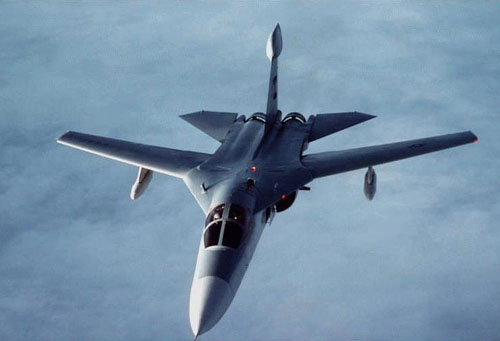EF-111 Raven
Summary
| Category | Military Special Mission Aircraft |
| Origin country | 🇺🇸 United States |
| Manufacturer | General Dynamics/Grumman |
| First flight | 1 January 1977 |
| Year introduced | 1981 |
| Number produced | 42 units |
| Average unit price | $65 million |
Description
In the late 1960s, the United States Air Force (USAF) sought a replacement for its aging EB-66 and EB-57 electronic warfare aircraft. An option studied was the United States Navy's EA-6B Prowler. The USAF desired a penetrating electronic jamming aircraft capable of supersonic speeds, and in 1972 decided to modify F-111As into electronic warfare aircraft. During January 1974, the USAF awarded electronic warfare study contracts to Grumman and General Dynamics. Grumman was selected as the EF-111 prime contractor in December 1974, then awarded a contract in January 1975 to modify two F-111As into EF-111 prototypes. The first fully equipped model, known as the "Electric Fox", flew on 10 March 1977. A total of 42 airframes were converted at a cost of US$1.5 billion. The first EF-111s were deployed during November 1981 by the 388th Tactical Electronic Squadron, based at Mountain Home AFB, Idaho, and the final aircraft was delivered in 1985.
The EF-111A was specifically designed as an electronic warfare platform and was unarmed. Its self-defense relied primarily on its high speed and acceleration. The aircraft retained the F-111A's navigation systems and a revised AN/APQ-160 radar, used primarily for ground mapping. Its primary electronic warfare feature was the AN/ALQ-99E jamming system, derived from the Navy's ALQ-99 used on the EA-6B Prowler. The ALQ-99E primary electronics were installed in the weapons bay, with transmitters fitted in a 16 feet (4.9 m) long ventral "canoe" radome, weighing approximately 6,000 pounds (2,700 kg). Receivers were installed in a fin-tip pod. The aircraft also utilized the ALR-62 Countermeasures Receiving System (CRS) as a Radar Homing and Warning (RHAW) system. To support this equipment, the aircraft's electrical and cooling systems were extensively upgraded. The cockpit was rearranged, with all flight and navigation displays relocated to the pilot's side, and flight controls except throttles removed from the other seat, where the electronic warfare officer's instrumentation and controls were installed. The Raven's engines were later upgraded to the more powerful TF30-P-9 of the F-111D, which produced 12,000 pounds-force (53 kN) dry and 19,600 lbf (87 kN) afterburning thrust. Between 1987 and 1994, it underwent an Avionics Modernization Program (AMP), which added a dual AN/ASN-41 ring laser gyroscope INS, AN/APN-218 Doppler radar, and an updated AN/APQ-146 terrain-following radar, as well as upgraded cockpit displays with multi-function displays. The EF-111 could not carry or fire anti-radiation missiles.
During 1983, the EF-111A achieved initial operational capability and was officially named Raven. Its combat debut was in Operation El Dorado Canyon against Libya in 1986, flying a distance of 3,500 miles with multiple aerial refuelings to disrupt Libyan air defenses while other aircraft bombed military facilities. In 1989, two EF-111As were deployed during Operation Just Cause in Panama to jam enemy apparatus. In 1991, 18 EF-111As conducted combat missions during the Gulf War against Iraq, accompanying strike packages and disabling Iraqi radars, making it the only unarmed manned aircraft to fly deep into Iraqi airspace. On 17 January 1991, an EF-111A achieved an unofficial kill against an Iraqi Air Force Mirage F1 by maneuvering it into the ground. During the mid-1990s, EF-111s were deployed to Aviano Air Base, Italy, for Operation Deliberate Force, and flew missions in Operations Provide Comfort, Northern Watch, and Southern Watch in the Persian Gulf. The final deployment was to Saudi Arabia until April 1998, after which the USAF began withdrawing them, with the last EF-111s retired on 2 May 1998, at Cannon AFB, New Mexico, marking the end of USAF F-111s in service.
Main Variants:
- EF-111A: This was the primary electronic warfare conversion of the F-111A, with a total of 42 conversions completed, including two prototypes used for testing and development.
Technical specifications
| Version: EF-111 Raven | |
|---|---|
| Crew | 1 pilot + 1 WSO |
| Maximum speed | 2414 km/h (1500 mph) |
| Wing area | 48.8 m² (525.2 sqft) |
| Wingspan | 19.2 m (63.0 ft) |
| Height | 5 m (16.4 ft) |
| Length | 23.5 m (77.1 ft) |
| Service ceiling | 17,000 m (55,774 ft) |
| Empty weight | 24,230 kg (53,418 lbs) |
| Max. takeoff weight | 39,680 kg (87,479 lbs) |
| Powerplant | 2 x Pratt & Whitney TF30-P-109 delivering 8390 kgf each |
Current operating countries
All operators

